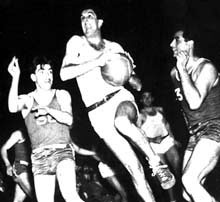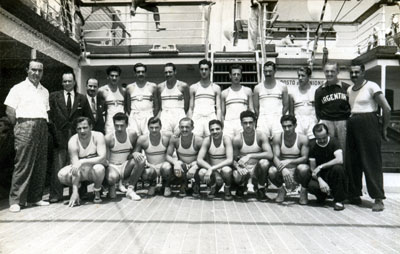The
1948 Olympics were held in London against a backdrop of a city still recovering from the
ravages of war. Argentina was one of fifty-nine countries to participate and only
one of twenty-three nations to send a basketball team.
Furlong was named as one of the fourteen members of the
basketball team. Due to post-war austerity, there was to
be no special treatment for the Olympic athletes and they
too would be subject to the same food rationing conditions
as the local populace. For the purposes of the games the
competitors were classed as heavy industrial workers and
their rations allocated accordingly. As with other nations
the Argentine delegation brought significant quantities of
food with them. Also among the Argentine delegation were
members of the Irish-Argentine institution Hurling Club,
who were participating in the field hockey competition.
Only
a short-time before, Mr Hawkes, president of the Argentine
Confederation of Basketball (CAAB), had appointed Jorge
Canavesi, former GEVP player and physical education
teacher, as team coach. Whilst Canavesi did not prove
particularly successful in the short-run, in the long-run
this turned out to have been an inspired choice.
The
Argentine basketball team was pitched against the
USA and Czechoslovakia, among others in Pool C. The basketball team came only
fifteenth out of twenty-three nations in an Olympics that
was defined for Argentina by Delfo Cabrera [6] winning the marathon. Yet they did
show some of their emerging talent in their pool game
against the USA, losing by a respectable 57-59. However, during that game
one Argentine player did stand out from the crowd and made
a lasting impression on the coaches and scouts present.
That was Furlong, who scored eighteen points in the game.
In an interview, Jorge Canavesi recalled that Omar
Browning, the American coach had said that ‘apart from
ourselves, Furlong of Argentina is one of the best players
in the world’ (Guterman & Gutiérrez, 2006a). He
also made a big impression on Adolph Rupp, the legendary
coach from the University of
Kentucky.
The
telegrams started flooding in with offers from the
US-American National Basketball Association (NBA) and
Furlong could have been the first player Argentine to play
in that league. The Minneapolis Lakers (now the Los
Angeles Lakers), even sent a contract ready for his
signature. The Baltimore Bullets were also on his trail.
However, Furlong had decided not to go to the USA and nothing would persuade him otherwise. In an interview
with the Argentine daily La Nación, he gave the following rationale for rejecting the offers
he had received from the NBA: ‘It was another age, where
amateurism was important. I had it in my head to go and
play at university, not as a professional. I had an offer
from Racing of Paris, to study in the Sorbonne. I left it
a while as I could not decide’ (La Nación, 2000). Given what was to transpire a few years later,
his steadfast commitment to the values of amateurism was
one of the many great ironies associated with his career.
Noting
the large number of countries that had decided to
participate in the basketball competition in the 1948
Olympics, William Jones, Secretary General of Fédération
Internationale de Basketball (FIBA) decided to push for
the a World Championship competition at a congress held in
the margins of the Olympics itself. A motion was carried
at the congress to organise a world championship every
four years in between the Olympic tournaments. The
inaugural championship, to take place in 1950, was awarded
to Argentina. There were a number of factors at play in awarding
Argentina
the inaugural championships: firstly, given that Europe
was shattered by the war, there was no country that had
the desire to hold it. Secondly, Argentina had a positive international image and had been a founding
member of FIBA in 1932 (CABB). Finally, Perón, who had
been a keen basketball player in his youth (Lupo 1999:
104), pledged his support. The venue for the event
was the iconic indoor arena, Luna Park, at the corner of Corrientes Avenue
and Leandro N. Alem Avenue in the centre of Buenos Aires; a venue inextricably linked with the modern history of
Argentina.
|

Oscar Furlong jumping
(Pedro Ferrandiz Foundation)
|
As
far as CABB and the coach Jorge Canavesi were concerned,
nothing was to be left to chance; the team of twelve
players [7] would undergo a long period of preparation to
avoid the pitfalls of the 1948 Olympics, where they
suffered a severe disadvantage in terms of team height.
Canavesi engaged in intense preparation, studying the
latest sports techniques emanating from Europe and the USA
and having them translated into Spanish. The team trained
in the River Plate football club complex in Nuñez. For
three months there was a gruelling schedule of six hours
of training per day, including a run everyday from Nuñez
down along Libertador Avenue to the Hipódromo in Palermo. Canavesi believed that the key was being faster and more
athletic than the other teams, as they could not compete
in terms of height. By contemporary standards, the
training regime was very advanced and included four
physiotherapists and an orthopaedist.
In
their opening game the Argentine team won 56-40 against
silver Olympic medal-holders France, which was a very promising start and pointed to even
greater things to come. Furlong scored twelve of those
points, Pichón fourteen points and the captain González
thirteen points. Although the game against fellow South
American rivals Brazil
was more difficult, Argentina also won 40-35.
The
defining game of the Championship took place on 3 November
as Argentina faced the USA for the gold medal spot. The Luna
Park arena was packed to capacity, with over 20,000 spectators
crammed into the venue. La Nación
reported that ‘already from early on, large numbers of
fans were in the vicinity, some to take a good vantage
point and others with a faint hope of finding tickets
which had been sold-out’ (Trenado, 2000). Basketball
fever had struck Buenos Aires. Both
Argentina
and the USA had unblemished records, both having won all five previous
games. The USA were represented by the AAU Denver Chevrolets. The
USA team had the distinct advantage of having the tallest
contingent in the tournament with no less than nine
players over 183cm.


